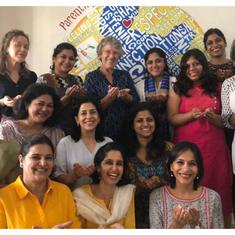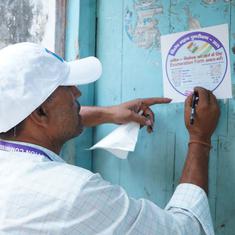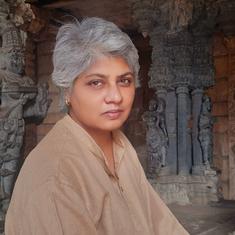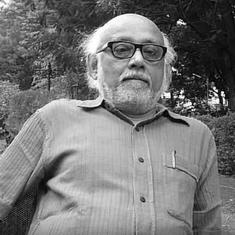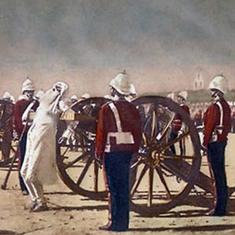Last week, a public event, started anonymously on Facebook, sent invites to the current students, seeking their support for an online campaign for “removal of useless course heads” at the institute, spilling the beans on what has been a hushed affair, confined to campus corridors for the past four months at least.
Following this, many students and faculty are also campaigning against the Director-General Sunit Tandon as well. Students and some faculty members spoke to Scroll and charged him with being a mute spectator, if not a party, to the events which have unfolded over the last few months.
“They will make their [students'] life hell if someone stands up,” said a current faculty of the English Journalism course on the condition of anonymity. “ IIMC is in a total mess. The institution is being destroyed by these people. He [Tandon] is here but only as a mute spectator in the scheme of things.”
Rough course
“The rumours seem to be true from the side of the students,” said Jijo Malayil, a student of English journalism at the institute who filed a Right to Information application to seek a response to how the former course head Vijay Parmar was heading two departments, English journalism and development journalism, at the same time.
“He was quickly sent on a two month leave after the RTI received a generic response,” Malayil said. “He hardly came to class for four-five months and only took one class in his time here.”
Another student, who chose to be anonymous, filed an RTI seeking the details of classes taken by all the teachers at the institute. “The response (picture below) has only confirmed that many teachers didn’t take enough classes and provided proof that we are not making this up,” he said.

Director General Sunit Tandon, however, responded to Scroll on email and said that the role of a course head is of academic administration instead, and no single faculty member runs the course independently. “How many classes and modules any faculty member teaches in a semester depends on the current needs,” Tandon wrote, adding that “a course director requires administrative ability and vision to run the course, irrespective of his or her core area of specialisation.”
The English Journalism department has a new course head, KM Shrivastava, but this has only added to the chaos at IIMC. Another student from the same batch said that she didn't expect this at a premier media institution. “The way things run here can be best described by the word 'haphazard',” she said, requesting anonymity. “Ever since the new course head has arrived, it has become even more focussed on rote learning with no preference given to the practical lectures.” Scroll's email to KM Shrivastava requesting his comment went unanswered.
A student claimed that practical skills are not being imparted, which would affect their professional careers. “I went to intern with a major English print magazine of the country but I was shown the door,” he said. “As a student of journalism, I didn't know how to edit, write copy or use layout software to be of any use to them. This is what they have done to us.”
Responding to this, Tandon claimed that these “allegations are not substantiated by facts” and said that “at least 62 classes have been allotted for lab journals, i.e. print journalism practicals, apart from practicals for areas such as broadcast journalism and new media. There are more practicals and theory papers to take care of instead of just reporting and editing papers.”
Brewing dissent
In January, a faculty member wrote a confidential letter (a copy of which is with Scroll) to Tandon highlighting these issues, but no action was taken. “I have fought for salvaging the future of this bright batch time and again,” the faculty member said. “But the nexus is such that no practical exposure or thinking abilities are being allowed to be nurtured among students. We have been ordered to keep them burdened with work so that they don’t have any time to think.”
It was a charge that was levelled in the letter to Tandon as well:
"In this power play, you have found your petty protagonists. The English Journalism course director, for instance, refuses to allow editors and journalists to come to the campus, speak and work with the students. How will students learn with no experience and interaction with industry professionals? How will it help them to get jobs? Last, he told me that foreign journalists from New York Times/WashingtonPost/The Guardian etc should not be called. If I suggest that sports/art and culture journalists, or film critics should be called, there is no response. This has been going on since the beginning of the first semester. Exactly similar was the pattern in the last EJ course of 2014. Why?
Time-tables are filled up with three hour classes as ritualistic, boring exercises, and I have been instructed that students should be given so much work that they should not think. If journalism students will not think, who will?"
Tandon admitted to receiving the letter but said that the faculty member had “tendered an apology” to him and the course heads for it. “He explained that he was persuaded to write the aforementioned mail in a vulnerable moment, due to his perception regarding certain developments in the English Journalism department, which, according to him, were coming in the way of EJ students learning and picking up skills, and therefore these had to be flagged for addressing them. He also took the opportunity to thank colleagues who had collectively pitched in towards the teaching process at the department as was reflected by the placements of EJ students in reputed organizations this year.”
Placement questions
Even the placement season this year was embroiled in controversy. The institute organised a fortnight long campus placement session that ended in February, but conflicting accounts emerge on its success as well. “We had an average placement season this time as only 30 out of 62 students have been placed in our batch,” said Malayil. The Director-General, however claimed that the placement numbers have gone up.
“The placements have been spectacular this year across courses and the placements are still continuing along with internships,” Tandon said adding that an unprecedented number of companies came to recruit. He, however, claimed that the official figures would only be available when the course ends.
Another student blamed the lack of internal coordination among departments. “It was never clear if the central placement session would even take place among the constant power struggles at the institution. I am relieved that the course is getting over finally.”




